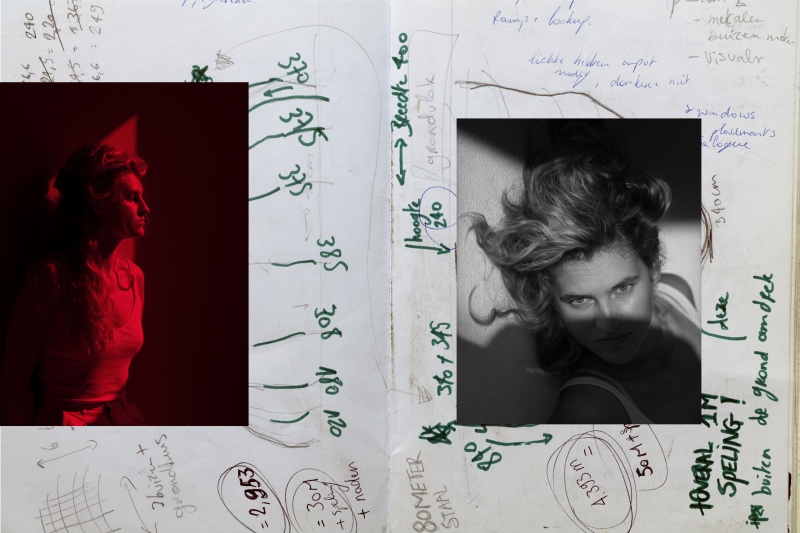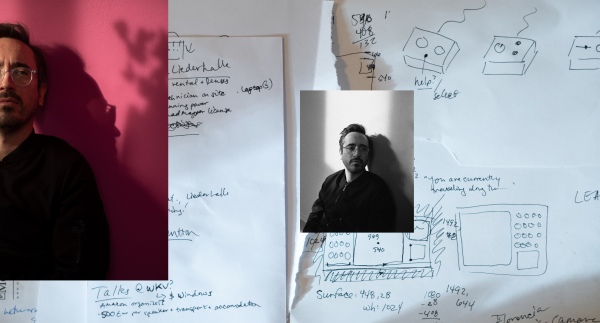The joy of making
Fleur Roggeman in conversation with Klara Czerniewska-Andryszczyk
-
You just finished your master’s degree last year – which was probably tough for you due to the pandemic. Can you tell me a bit about your background?
- I did my bachelor’s degree in autonomous art – i.e. fine arts, specialising in sculpture. And for my master’s degree at the same academy – the Sint Lucas in Antwerp – I chose applied arts, because I was keen to explore the thin line between sculpting and scenography. I am really into design, installation art and scenography – these are the three big topics that I refer to in my work.
-
Why Poland? What brought you here?
- It’s a funny story; a sequence of coincidences, actually. Last year, right after graduating, I was able to attend an interactive workshop week in Poland. I wanted to make an interactive visual work based on sound. I was struggling with it because I was learning everything by myself, through tutorials. I was coding everything, despite not having a computer background. By pure chance, I discovered that there was a call for applications to do this one-week workshop in Poland, at the Polish-Japanese Academy of Information Technology (PJATK). It’s a great school and the courses they provide are really interesting. I also made some new friends there – we’re still pretty close, even though we only worked together for one week. After this workshop, I sent birthday wishes to one of the girls I met there; posted on her social media with a photo from Warsaw. And then there was a guy, Pierre, who wrote: oh, I know this place! I’m doing a residency here, maybe you would like to come over, too? And I was like, okay, sure!
-
So what happened next?
- During the workshop at PJATK, we also had to present ourselves in front of a number of embassies and institutions. The General Representation of the Government of Flandersbecame interested in the installation piece that I had made for my master's project. They invited me to recreate it in June / July, for an event they are organising here in Warsaw. It will be placed in front of U–jazdowski.
-
Wow, that’s great! Can you tell me about this installation?
- It’s like a giant cave, three metres high, four metres wide and six metres deep. With it, I wanted to make an immersive installation that could function both in a white cube as well as outdoors. People even asked if I would rent it to them as a chapel or a canopy where they could get married, which was really exciting! My idea was to make it as multifunctional as possible, because I believe that there is already too much stuff in the world, so we should learn to use the things that are already there.
-
There seems to be some tension between contemporary art and design. Also, you don’t hear the terms “applied arts” or “autonomous arts” that much anymore. What’s your view on that?
- I had the opportunity to try something new while at school. As I mentioned, when I finished my bachelor’s degree, I was able to shift between applied and fine arts. However, this was the first year that it was done at Sint Lucas and I was the only person who moved from the fine arts to applied arts department. To be honest, I didn’t feel that I got enough support. I shared a class with all those cool graphic designers and illustrators, who eventually became my friends, but when I was to present my own work, the teachers were unable to understand my approach.
-
Perhaps they were trained as craftsmen, perfecting certain (mostly manual or visual) skills?
- Yes, and within the ‘fine arts’ section, there is a different philosophy. But on the other hand, I went to a Steiner School before, which is a specific kind of high school where you can learn woodworking, knitting, etc. I am also really inspired by design and scenography – for me, it’s a way to ‘swallow’ visitors into my world. On the other hand, what I dislike about fine arts is that there is too much distance between the object and the spectator: be it a sculpture or a painting. What I care about is triggering the senses – which is why I work a lot with sound. It’s something you don't see and then evaporates so easily: it’s there for a moment and then it’s gone – this is fascinating.
-
What will you be working on while on this residency?
- Ever since I arrived, I have been thinking a lot about my practice, trying to pinpoint where – and who – I am. Am I a designer? Am I a scenographer? Am I a sculptor? Or maybe an installation artist? Am I allowed to be all of these at the same time? I find it hard to answer those seemingly simple questions because, apart from my own work, I started to create a business platform to help my parents with their catering business (they cater to a lot of weddings, so I’m also helping them out with styling etc), and I also organise a festival called Nectar. So my answer is always: “I do a lot of stuff”... As for the residency here, I am revisiting an installation I made for my bachelor’s project. It was a series of round plexiglass plates, which I am recreating using recycled plexi that I can print on. The residency made it possible for me to just enjoy the practice of making stuff: I started to do embroidery again, which I find to be a very meditative act. I have also been playing with clay, gathering a lot of prints – and all of this without the feeling of being stuck in my head. It feels as if I have started breathing again, I am having fun again! I also bought an analogue camera and, although some pictures came out a bit distorted, I kind of liked it. All these visuals – the patterns I embroider, the photos etc – will be printed on recycled plexiglass plates and installed one next to another in the final piece. The transparency of the plexi is key: it’s like a transparent sketchbook, or archive, and it also represents my transparency towards the audience – a sincerity that is very important for me. I strongly believe that my joy and the peace of mind I felt while making the work is captured in it and transferred onto the audience.
-
Will this also be an immersive installation for the viewers to enter?
- Yes. As I said, I am greatly inspired by scenography. As Es Devlin, a well-known scenographer and a huge inspiration of mine, once said during a Ted Talk, when you are standing outside a church (she was referring to the All Saints Church in Tudeley, with stained glass windows by Marc Chagall from 1967), the windows don’t “speak”, the glass is black. But when you look at it from the inside, the work comes to life. The paintings are activated by the light that enters the church. That's the same approach for scenography in general. It is common for a scenographer to start with a black box, so everything is dark (as opposed to the proverbial white canvas for painters). Then, you start adding light in a sculptural way to create a new, interesting environment. A scenographer is actually a sculptor of light. The fact that I print on a transparent surface comes from the same idea. The installation will be activated by light, thus referring to the same scenographic approach that is visible in most of my works.
-
What's your approach to the white cube? A white cube is a space that can be filled with anything you come up with...
- That’s true, but I think in a white cube, you can only reach a certain number of people. And what I am interested in is getting people together and interacting with them on a larger scale. I am not saying that I won’t be collaborating with any art gallery in the future, I am not prejudiced against that. But there's so much stuff put in to white cubes, why would I want to put mine there as well... That’s how I came up with Nectar.
-
Can you tell me more about it?
- Nectar is yet another by-product of my master’s degree installation, which I wanted to test and use. I wanted it to become a stage, so I decided to launch a festival in my hometown of Limburg, taking advantage of my family’s expertise in event planning. I was going to do it this summer, but there is a big “maybe” still, due to Covid. I want Nectar to become a meeting place for all the arts: from music to visual arts, to slam poetry and dance... I want to create a space where people can get together, without any boundaries.
- Warsaw, 21 April 2021


